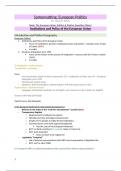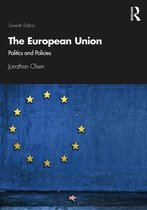Samenvatting: European Politics
Dr. Wouter Wolfs
Boek: The European Union: Politics & Policies (Jonathan Olsen)
Institutions and Policy of the European Union
Introduction and Political Geography
European Politics?
1. Institutions and Policy of the European Union
Focus on institutions, decision-making processes and policies = situation since Treaty
of Lisbon (2009)
4 credits
2. European Integration since 1945
Focus on the history of the process of integration = process until the Treaty of Lisbon
(2009)
2 credits
To distinguish = onderscheiden
To estimate = inschatten
Exam
- One examination (date) for both components: 2/3 < Institutions & Policy and 1/3 < European
integration since 1945
- Closed-book, written exam
- Questions: both knowledge & understanding (+ link with topical issues in EU)
Topical issues = Actuele kwesties
- Language: examination questions are in English, your answers can be in Dutch (or English)
Classes until Friday 28/4/2023
Topical issues, like Qatargate
Is the European Parliament really lacking transparency?
- Reforms in the wake of the “Cash-for-amendments” scandal (2011)
- Transparency Register
o Requirement for lobbyists to register
o Detailed overview of budget and personnel
o Employ 10-15 people to lobby the EU-institutions
o (Commissioners only meet registered lobbyists)
Not the case of the European Parlement
o BUT: no third countries (for example: Qatar or Morocco)
o BUT: quid assistants?
Does not have to be registered
- Legislative “footprint”
o List of interest representatives that MEP met in preparation of legislative file
o BUT: not for other MEPs
Is it wrong for MEPs to submit amendments they received from interest representatives?
1
, - Code of Conduct for MEPs (Guiding principles)
- They need to insert the ‘Declaration of Financial Interests’
- Main problem = enforcement
o Responsibility of EP President after consulting Advisory Committee
The Political Geography of Europe & “Mental Maps”
Why are different maps of Europe important?
o Official map of the European Union is only one side of the story
o Multitude of maps exist about the political geography of Europe
o Maps are not neutral: they contain normative motives and aspirations and specific
interpretations of the present (“mental maps”)
Maps can help to explain:
o Relations and attitudes between member states and/or populations
o Political dynamics and tensions within and between countries
o How we think ourselves about Europe and European integration (self- reflexion)
Example: 2 maps
- Focus on Poland
- Didn’t want to take any refugees at first, but during time (war in Ukraine and all their
implications/consequentions) made Poland take them
- Some countries took many, some almost none
The past of the European Union is an important explanation for the present of the European Union
1957 < 1973 < 1981 < 1986 < 1990 < 1995 < 2004 < 2007 < 2013 < 2020
Path dependency: decisions of the past have implications for the future
Important for decision-making
Joining the EU < Sometimes for logistical, sometimes for logical reasons
Work together to control each other
Establishment of the international market < Big role for the EU
When Greece joint, they weren’t ready (too early) + problem with state finance which led to the
collapse of Greece and almost to a collapse of the whole European market
Yanukovych (or Janoekovytsj) wins (= pro-Russia): President of Ukraine from 2010 until 2014
The European Union isn’t the only (or a coherent) manifestation of integration on the European
continent
NATO
Council of Europe
…
2
,Chapter 1: What is the European Union?
Actuality
- Visit of Biden in Poland and in Ukraine (Zelensky)
- Consequences of Russian Invasion for internal dynamics in EU?
o Is the center of power in the EU moving eastwards?
o End of French-German collaboration as “engine”” of European integration?
Engine = motor
A lot of attention for relationship between France and Germany
o Political adulthood of “new” member states in CEE
CEE = Central and Eastern Europe
Poland delivers arms to Ukraine, which makes them feel as powerful as the “old”
West-European countries (member states)
o BUT: Interests are not symmetrical (between regional partners)
Map: Coalitions or alliances – Regional groups in the European Union
o Partners in some policy fields, whereas competitors in others (they protect each other)
Whereas = terwijl
Example: Poland and Hungary
Partners: Rule of law conflict with the EU, structural funds…
Competitors: Foreign policy (vis-à-vis Russia), migration?
Mostly Hungary who are against
Different visions in Poland and Hungary
= positive for European integration – Fact that interests are oppositional (coinciding cleavages can
be disruptive)
Coinciding = samenvallend
Cleavages = splitsingen
o BUT: Hard parameters and power relations still matter
Voting rights depends on populism < Most populist countries have an advantage
Old member states (BE, FR, the Netherlands, SWE, FIN, DEN, IRE…): will grow
Eastern countries: population will slink
Expenditure for defense < What are the power relations (PL still quite limited)
Expenditure = uitgaven
Economic < Central, Western and Northern Europe = richest countries
Question of today’s lesson: “What is the European Union?”
Easy question – Difficult answer (What do we think…)
Member states have autonomy
The European Union is like an elephant
o It depends on how you look at it, which meaning/interpretation you give
o Where going to discuss different theories/concepts (or lenses) the look at the EU
Chapter overview
- How we approach the EU still depends in large part on how we think about the role of the state
- At least 5 ways to conceptualize the EU
1. An international organization
2. A regional integration association
3. A political system in its own right
4. A unique entity
5. Something that exhibits and combines all 4 of these
To exhibit = tentoonstellen
3
,- 2 broad categories of theories that analyze the EU
1. Those explaining how the EU evolved
a. Neofunctionalism
b. Intergovernmentalism
2. Those explaining what it has become
- Multi-level governance has emerged as one way to understand the EU as a political system
- Rather than being portrayed as an international organization, the EU is now increasing as a
political system in its own right
What is a state? The role of the state
States rule: make laws and enforce them
Enforce = afdwingen
States provide public goods
o Public goods: you cannot exclude people from using it = non-exclusive good & also
unlimited (Examples: climate, national security… Non-public goods: theater
tickets…)
States extract (taxes) – From society, people that life on their territories
Extract = heffen
States solve collective action problems
o You need an action that needs collaboration
o Problem because people have individual interests
o You need to collaborate, but you’re not really interested in collaboration because of
your own individual interests
o For example: Climate change (you don’t want to change your habits, but if everyone
thinks like that, the problem won’t be solved…)
Europe is a state (arguments pro and contra)
They work together to solve the problems in Ukraine-Russia, and they impose sanctions to
Russia (+)
They rule (+)
Monopoly in the use of violence (-)
Each member state extracts taxes individually (-)
“Order/Peace of Westphalia” (1648)
- Is taken as a convenient starting point of how long states have been important to an
understanding of the ways in which societies are governed < The international state system has
existed since then
- Established West Federal Order (Established = gevestigd)
- New political order (system) was established in Europe
- Based on peaceful collaboration: Brought an end to 2 European wars and resulted in many
territorial adjustments
Adjustments = aanpassingen
- Recognition that state had sovereignty of its territory
A state has 4 main characteristics:
1. Fixed and populated territory
2. Possibility to impose authority over that territory
3. Legally and politically independent
4. Recognized by its people and by other states
Sovereignty = “supreme” authority over a territory and its population (Supreme = opperste)
4
, State
o Political-legal unit defined by territory and by laws
o A legal and physical entity that operates within a fixed and populated territory, has
authority over that territory, is legally and politically independent and is recognized
by its people and by other states
o Institutional basis
Nation
o A group of people defined by shared identity or culture based on language, ethnicity,
religion etc.
o Difference nation & ethnic group
Ethnic group: a group of people who share a heritage, common language,
culture (often including religion) and can discuss shared ancestry
Heritage = erfenis
Nations (more political): unified by a sense of purpose to control the territory
that the members of the group believe to be theirs.
Unified = verenigd
Nation-state
o Sovereign states in which a majority of the population is united based in factors that
define a nation
Limitations of the concept state
Nationalism: state should be based on a “nation”
o National superiority, ethnocentrism, racism and genocide
o Tensions between states
International cooperation to overcome tensions + promote cooperation
o Manifestation: International organizations and/or international treaties (= voluntary
cooperation)
o Example: United Nations
o Core aspect = a treaty (Core = kern)
Integration Collaboration
Collaboration Integration
Member states decide to achieve certain goals The authority to take decisions is transferred to
together by taking joint measures, but the a higher (supra-)national level, so there is a
member states retain authority over the transfer of competences from the member
specific policy domain states to the EU level
Joint measures = gezamenlijke maatregelen
Retain = behouden
Some international organizations lead to integration
Integration
= transfer by states of (parts of) sovereignty
= pooling of authority in specific policy areas and the creation of common institutions with
restricted powers (delegation)
≠ The total surrender of their own separate legal, political, economic, social and national
identities (= assimilation)
5





